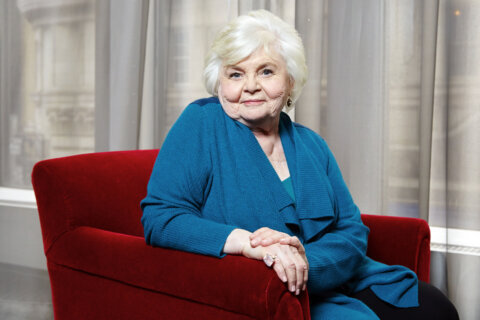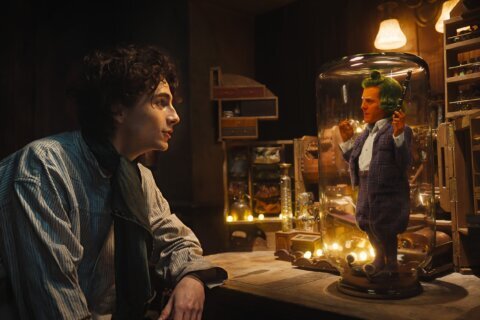Jason Fraley, WTOP film critic
WASHINGTON – With recent revelations that the Holocaust was even worse than we thought, there’s no substitute for the archival footage of documentaries like “Shoah” (1985) and “Night and Fog” (1955), which Francois Truffaut called the greatest movie ever made.
Their images, frozen in time, will always carry more weight than Hollywood’s “The Diary of Anne Frank” (1959) or “Sophie’s Choice” (1982). But if any narrative “fiction” film ever captured the dual horror and survival spirit of the Holocaust, it was “Schindler’s List” (1993).
“‘Schindler’s List’ is like looking through a tiny little pinhole at the most monstrous event of man’s inhumanity against man in recorded history,” director Steven Spielberg said.
This week, Universal marks the film’s 20th anniversary with its first-ever high-def release on Blu-ray, and yet, it feels like just yesterday that Spielberg’s masterpiece won seven Oscars, including Best Picture. This may be because its theme just carried us through another Spielberg war biopic in “Lincoln” (2012): one man’s lonely quest against intolerance. Perhaps it’s because its images are still seared into our brains: ashes of human flesh falling like snowflakes; conveyer belts dropping emaciated bodies into a fire pit; a young boy so desperate as to hide in the feces of a latrine. Or, perhaps its plot now feels like textbook history: Oskar Schindler, wealthy member of the Nazi Party, who traded it all to save 1,100 Polish Jews from annihilation.
Whatever the reason, we have never forgotten. Today, “Schindler’s List” is hailed by both the critics and the public, voted No. 8 on the AFI’s Top 100 and No. 8 on the IMDB fan poll. While “Citizen Kane” tops the AFI list, it falls to No. 46 on the IMDB fan poll, and while “The Shawshank Redemption” tops the fan poll, it’s down at No. 72 with the AFI experts. Only “Schindler” and “The Godfather” make the Top 10 of both lists, championing that rare blend of academic and mainstream appeal.
So, 20 years later, what exactly makes “Schindler’s List” so revered and so beloved?
![]()
The Script
The root of every great movie is a great script. Screenwriter Steve Zaillian (“Moneyball,” “Gangs of New York”) earned an Oscar for his adaptation of Thomas Keneally’s acclaimed novel “Schindler’s Ark.” The title is fitting, considering the film charts “Schindler’s arc,” as in his character arc. In the beginning, he says he’ll be remembered for making so much money. In the end, he laments not giving more of his money away in order to save more Jews from concentration camps. Throughout this transformation, Zaillian walks the tonal tightrope, mining eye-watering inspiration from the depths of darkness, just like its two colleagues in the AFI’s Top 3 Most Inspirational Films: “To Kill a Mockingbird” (1962) and “It’s a Wonderful Life” (1946). For all this, Zaillian’s script ranked No. 49 on the WGA’s Top 101 Screenplays of All Time.
![]()
The Acting
Such character arcs would not have worked if not for great performances. Today, audiences know Liam Neeson from “Taken” and “Batman Begins,” but he was never better as Oskar Schindler, turning him into the AFI’s No. 13 Greatest Hero of All Time. On the dark side of the same coin is Ralph Fiennes, whom kids now know as Voldemort in “Harry Potter,” but who was never better as Amon Goeth, sniping prisoners from his balcony before taking his morning piss, creating the AFI’s No. 15 Villain of All Time. Finally, third wheels don’t get any better than Ben Kingsley, Best Actor from “Gandhi” (1982), who carried a copy of “The Diary of Anne Frank” in his pocket during filming and literally shook while delivering the film’s seminal line: “The list is an absolute good. The list is life.”
“All of us on the set had this enormous privilege of being the voice of a terrible period and saying to the audience, ‘Ladies and gentlemen, it breaks my heart to tell you, but it’s all true,'” Kingsley said.
![]()
The Music
Even with the script’s eloquent dialogue and actors’ power performances, it would all have been rendered meaningless if not for the proper soundtrack. For this, Spielberg turned to favorite composer John Williams.
“When he showed me ‘Schindler’s List,’ I was so moved I could barely speak,” Williams told The Guardian. “I remember saying to him, ‘Steven, you need a better composer than I am to do this film.’ And he said, ‘I know, but they’re all dead.'”
The result will live on long after Williams is gone. After scoring “Jaws,” “Star Wars,” “Close Encounters of the Third Kind,” “Superman,” “Raiders of the Lost Ark,” “E.T.” and “Jurassic Park,” Williams somehow topped himself again with “Schindler’s List” with a heart-wrenching violin bow sliding across our heart strings. The score earned Williams his fifth and final Oscar for Best Original Score.
![]()
The Vision
Just as Williams was intimidated to score “Schindler’s List,” Spielberg was initially hesitant to take on the project. He first got his hands on the book “Schindler’s Ark” a year after directing “Raiders of the Lost Ark,” but he didn’t quite feel ready. As Spielberg said, “It took me 10 years of emotional development in order to say, ‘Now I’m ready to make Schindler’s List.'”
It was well worth the wait, as Spielberg matured from the maker of mass entertainment to true cinematic artist, finally winning his first Oscar for Best Director with “Schindler’s List” and setting up his second win for “Saving Private Ryan” (1998) five years later.
The 20-year wait underscored highbrow Oscar stereotypes as the Academy only accepted Spielberg after making a slower-paced, European-based historical drama, when he could have just as easily won for “Jaws” (1975), a damn well-made movie, or “E.T. The Extra Terrestrial,” which brought a standing ovation at Cannes. Award season is a funny thing, but take solace in knowing that “Schindler’s List” holds Spielberg’s best directing, a string of techniques fit for any film theory class. Strap on your backpacks; it’s time to go to school:
Slow Disclosure: Spielberg introduces us to Schindler without showing his face. Instead, we get close-ups of his belongings: a cuff link, a tie loop, an arm moving through a sleeve like a magician, a pocket handkerchief, German Reichsmarks, a watch and a Nazi pin. We then follow Schindler in a tracking shot, staring at the back of his head, allowing him to leave the frame, then waiting for just the right time to show our hero’s face.
Transitions: In the above clip, you’ll notice flashbulb freeze frames similar to Scorsese’s “Raging Bull” (1980). They display Spielberg’s masterful use of transitions, as “Schindler” repeatedly wipes the screen with typewriter close- ups similar to “All the President’s Men” (1976). My favorite transition comes in the beginning as Spielberg tilts upward on the rising smoke of a modern Jewish holiday candle, then tilts back down on the smokestack of a 1940s train. My second favorite is the disturbing transition from a Mazel-tov glass smash to Goeth’s brutal beating of Helen Hirsch.
Montage: Helen’s beating also displays Spielberg’s use of montage in the rapid cutting of various images. The montage technique most effectively works as Schindler auditions various secretaries. With each cut, Schindler gets closer and closer to the attractive girls he’s auditioning, until finally, we cut to an unattractive typist where Schindler sits far away, unimpressed. Without any dialogue, Spielberg has visually painted Schindler as a shrewd womanizer, using distance between two characters to make a point (like Welles at the dinner table with his wife in “Citizen Kane”).
Single Take: Of course, quick cutting is not always best. Different scenes call for different directorial techniques. So, in a scene where Goeth’s gun jams as he tries to execute a Jewish worker, it makes more sense for a long single-take, as we experience the real-time suspense along with the victim.
Power Roles: The duration of the shot isn’t the only effective technique. The angle of the shot is equally telling, as in the scene where Schindler’s wife Emilie walks in on him and his mistress. As Schindler sits in a chair beneath her, we cut to a high-angle shot where the wife is larger in the frame, looking down on a small Schindler. First-time viewers may not notice such a technique, but it subconsciously makes us feel like Schindler is emotionally smaller, and the wife has the moral high ground.
Mise-en-Scene: Don’t be intimidated by the fancy film term: it’s just a fancy French word for the symbolic placements of all elements in the frame. This is used in a wideshot of Neeson and Fiennes with a vertical shadow dividing them. Fittingly, when Helena enters the room, she stands on Schindler’s side, visually begging for him to save her from Goeth. Also, note the “mise-en-scene” of Spielberg’s shots through window panes. The first time we meet Schindler in his greedy Nazi state, he appears to the left side of a window pane. Later, after he sees the light and tries to save Jewish workers from Goeth, note that Goeth is now on the left side of the window pane and Schindler is on the right. In other words, he is now on the right side of history.
Objective vs. Subjective Camera: “Schindler’s List” is also perfect to teach the difference between objective camera (observing from the distant eyes of fate) versus subjective camera (seeing things from a character’s point of view). This is on clear display in Goeth’s sniping scene, with objective shots of he and his rifle, and POV shots through his scope. Spielberg did the same for Vin Diesel’s demise in the sniping scene of “Saving Private Ryan.”
Diegetic Sound:Throughout the film, Spielberg blends these visual techniques with powerful audio elements. Case in point: during the liquidation of Krakow, a high angle shows the town’s building windows lighting up with flashes of gunfire to a chillingly upbeat Bach piano accompaniment. This music is played by a Nazi soldier, highlighting the difference between diegetic sound (sound coming from an on-screen source) and non-diegtic sound (sound coming from an off-screen source, like John Williams’ musical score).
Black & White vs. Color: Perhaps most important is Spielberg’s decision to shoot in black-and-white, reflecting the historical photographs of any Holocaust textbook. These were made all the more real by shooting on location in Schindler’s actual factory, his actual Krakow apartment and outside the actual gates of Auschwitz, and the decision to shoot roughly 40 percent of the film with hand-held cameras. The black-and-white images earned cinematographer Janusz Kaminski the first Oscar of his career, setting up his second win for “Private Ryan” and six total nominations, including “Lincoln.”
“I tried to be as close to a journalist in recording this re-creation, more than being a filmmaker trying to heighten the suspense or action or the pathos,” Spielberg said. “The black-and-white and hand-held camera gives the film sort of a ‘cinema verite,’ documentary feel. It embodied the truth we were trying to explore and communicate what happened. It made it seem more real, somehow.”
This black-and-white reality is momentarily broken by a touch of red. As Schindler watches the 1943 liquidation of the ghetto, he focuses on a young girl, making her way through the chaos, wearing a bright red coat. Spielberg’s goal is to highlight the importance of a single, solitary life, setting up a shockwave of emotion when we get the payoff later in the film. The actress who played the young girl, 24- year-old Oliwia Dabrowska, recently said she regretted watching the traumatic film at such a young age, vowing to never watch it again. She promised Spielberg she’d give it another shot another shot at age 18 and realized she was part of something special.
![]()
Legacy: The 20th Anniversary Blu-ray
Just like the little girl in the red coat, we should all go back and give “Schindler’s List” another look. The 20th anniversary Blu-ray is the perfect chance to do that, despite a disappointing set of Bonus Features. The “Voices from the List” documentary is a powerful 1-hour-16 minute-collection of testimony from many of the same Schindler Jews who appear in the film’s final sequence, walking hand-in-hand with the actors who portrayed them and placing stones on the real-life Schindler gravestone. However, this documentary was already featured on the last DVD release.
The only new features are a 4:42 advertisement for the USC Shoah Foundation and a 3:34 promo for the iWitness program, both raising awareness for the Holocaust and other modern genocides from Rwanda to Darfur, Cambodia to Armenia, Bosnia to Herzevgovina. Spielberg appears in the doc to say, “All these examples of intolerance and racial hatred have to be taught so the young people, the next generation, will never let this happen again.”
Despite the lack of new bonus material, the Blu-ray is well worth the price of admission solely for the hi-def version. “Schindler’s List” has never looked better, proving that black-and-white films, when remastered properly, can look just as sharp as the latest color releases. It’s also a worthwhile purchase to have the entire film on one Blu-ray disc, compared to the old DVD set that divided the 3-hour movie onto two discs right as a Nazi official announces the Final Solution — an abrupt intermission that kills the film’s momentum.
A lot has changed since “Schindler’s List” — Spielberg has created the TV miniseries “Band of Brothers” (2001) with a “Why We Fight” Holocaust episode; Quentin Tarantino has given Jews revisionist history revenge in “Inglourious Basterds” (2007); and Kate Winslet has won an Oscar for her Holocaust portrayal in “The Reader” (2008). But the more things change, the more they stay the same, as we continue to hear Holocaust denials from leaders like Iran’s Mahmoud Ahmadinejad.
Such statements remind me of a scene in Woody Allen’s “Hannah and Her Sisters” (1986), where Max von Sydow cites the Holocaust for the dark possibilities of mankind: “The question is not how could this happen, but why doesn’t it happen more often?” With such a thought, it’s all the more important for prominent voices to keep the Schindler candle burning.
“No one can do anything to fix the past,” Spielberg said. “The Holocaust already happened. But a picture like this can impact us, delivering a mandate about what must never happen again.”
★ ★ ★ ★
The above rating is based on a 4-star scale.
Follow @JasonFraleyWTOP or check out his blog The Film Spectrum.










